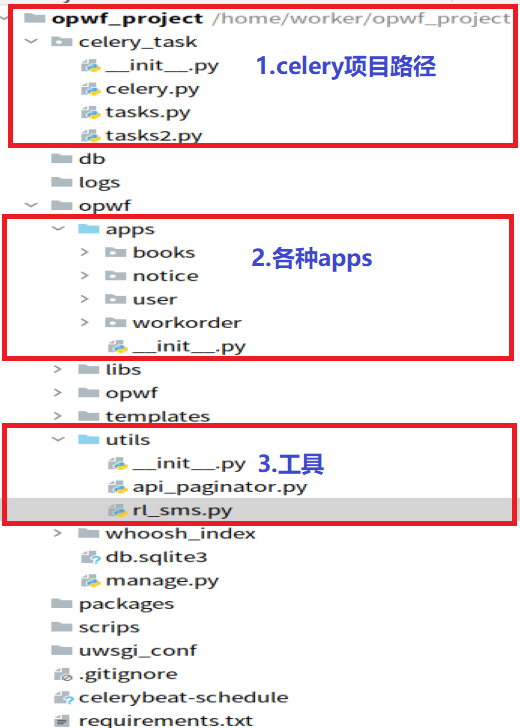07.celery在项目中使用和在Django中使用比较
1.1 为什么有这篇博客
1.博客说明
1.在做celery异步任务和定时任务时,有些人使用django-celery+django-redis+celery+redis+django-celery-beat实现
2.但是这种实现方法和django结合过于紧密,不利于分布式部署
3.而且不同版本相结合,一旦不小心安装升级一个包,会导致各种报错
4.配置也比较繁琐,很多同学在使用时易出错
2、安装相关包
pip install Django==2.2
pip install celery==4.4.7
pip install redis==3.5.3
1.2 celery基本使用
1、创建tasks.py文件进行验证

from celery import Celery import time app = Celery('TASK', broker='redis://localhost', backend='redis://localhost') @app.task def add(x, y): print("running..add.", x, y) return x + y @app.task def minus(x, y): time.sleep(60) print("running..minus.", x, y) return x - y
1、启动Celery Worker来开始监听并执行任务
celery -A tasks worker --loglevel=info # tasks是tasks.py文件:必须在tasks.py所在目录下执行
2、调用任务:再打开两个终端,进行命令行模式,调用任务
>>> import tasks
>>> import tasks
>>> t2 = tasks.minus.delay(9,11)
#然后在另一个终端重复上面步骤执行
>>> t1 = tasks.add.delay(3,4)
>>> t1.get() #由于t2执行sleep了3s所以t1.get()需要等待
2、celery其他命令
>>> t.ready() #返回true证明可以执行,不必等待
>>> t.get(timeout=1) #如果1秒不返回结果就超时,避免一直等待
>>> t.get(propagate=False) #如果执行的代码错误只会打印错误信息
>>> t.traceback #打印异常详细结果
1.2 在django项目中使用
1、目录结构如下

2、opwf_project/celery_task文件夹

# celery.py # -*- coding: utf-8 -*- from celery import Celery import os,sys import django # 1.添加django项目根路径 CELERY_BASE_DIR = os.path.dirname(os.path.abspath(__file__)) sys.path.insert(0, os.path.join(CELERY_BASE_DIR, '../opwf')) # 2.添加django环境 os.environ.setdefault("DJANGO_SETTINGS_MODULE","opwf.settings") django.setup() # 读取配置 # 3.celery基本配置 app = Celery('proj', broker='redis://localhost:6379/14', backend='redis://localhost:6379/15', include=['celery_task.tasks', 'celery_task.tasks2', ]) # 4.实例化时可以添加下面这个属性 app.conf.update( result_expires=3600, #执行结果放到redis里,一个小时没人取就丢弃 ) # 5.配置定时任务:每5秒钟执行 调用一次celery_pro下tasks.py文件中的add函数 app.conf.beat_schedule = { 'add-every-5-seconds': { 'task': 'celery_task.tasks.test_task_crontab', 'schedule': 5.0, 'args': (16, 16) }, } # 6.添加时区配置 app.conf.timezone = 'UTC' if __name__ == '__main__': app.start()

# -*- coding:utf8 -*- from .celery import app #从当前目录导入app import os,sys from .celery import CELERY_BASE_DIR # 1.test_task_crontab测试定时任务 @app.task def test_task_crontab(x, y): # 添加django项目路径 sys.path.insert(0, os.path.join(CELERY_BASE_DIR, '../opwf')) from utils.rl_sms import test_crontab res = test_crontab(x, y) return x + y # 2.测试异步发送邮件 @app.task(bind=True) def send_sms_code(self, mobile, datas): sys.path.insert(0, os.path.join(CELERY_BASE_DIR, '../opwf')) # 在方法中导包 from utils.rl_sms import send_message # time.sleep(5) try: # 用 res 接收发送结果, 成功是:0, 失败是:-1 res = send_message(mobile, datas) except Exception as e: res = '-1' if res == '-1': # 如果发送结果是 -1 就重试. self.retry(countdown=5, max_retries=3, exc=Exception('短信发送失败'))

# -*- coding:utf8 -*- from .celery import app import time,random @app.task def randnum(start,end): time.sleep(3) return random.randint(start,end)
3、opwf_project/opwf/utils

# -*- coding: utf-8 -*- # utils/rl_sms.py from ronglian_sms_sdk import SmsSDK from user.models import User accId = '8a216da8747ac98201749c0de38723b7' accToken = '86072b540b4648229b27400414150ef2' appId = '8a216da8747ac98201749c0de45123be' def send_message(phone, datas): user = User.objects.all()[0] print(user.username, '%%%%%%%%%%%%%%%%%%%%%%%%%%%%%%%%%%%%%%%') sdk = SmsSDK(accId, accToken, appId) tid = '1' # 测试模板id为: 1. 内容为: 【云通讯】您的验证码是{1},请于{2}分钟内正确输入。 # mobile = '13303479527' # datas = ('666777', '5') # 模板中的参数按照位置传递 # resp = sdk.sendMessage(tid, phone, datas) print("##########################################") print('执行了这个方法 send_message') return '' def test_crontab(x,y): print('############### 执行test_crontab测试任务 #############') print('############### 邮件审批超时提醒 #############')
4、在django项目中调用
def handle_next_suborder_approve(suborder_obj):
# 函数内部导报
from celery_task import tasks
# .delay()发送异步任务
tasks.send_sms_code.delay(18538752511,()) # 通知审判者
5、执行命令
### 1.1 进入执行目录
cd opwf_project
### 1.2 celery管理
celery -A celery_task worker -l INFO # 单线程
celery multi start w1 w2 -A celery_pro -l info #一次性启动w1,w2两个worker
celery -A celery_pro status #查看当前有哪些worker在运行
celery multi stop w1 w2 -A celery_pro #停止w1,w2两个worker
# 1.项目中启动celery worker
celery multi start celery_task -A celery_task -l debug --autoscale=50,10 # celery并发数:最多50个,最少5个
# 2.在项目中关闭celery worker
ps auxww|grep "celery worker"|grep -v grep|awk '{print $2}'|xargs kill -9 # 关闭所有celery进程
```
### 1.3 django_celery_beat管理
# 1.普通测试启动celery beat
celery -A celery_task beat -l info
# 2.在项目中后台启动celery beat
celery -A celery_task beat -l debug >> /aaa/Scheduler.log 2>&1 &
# 3.停止celery beat
ps -ef | grep -E "celery -A celery_test beat" | grep -v grep| awk '{print $2}' | xargs kill -TERM &> /dev/null # 杀死心跳所有进程
作者:学无止境
出处:https://www.cnblogs.com/xiaonq
生活不只是眼前的苟且,还有诗和远方。

